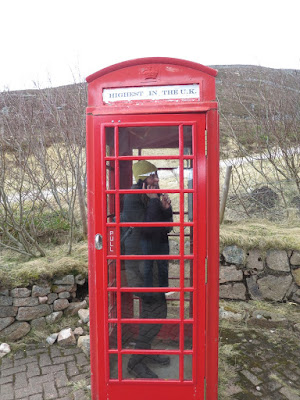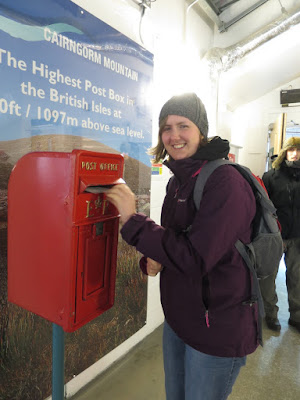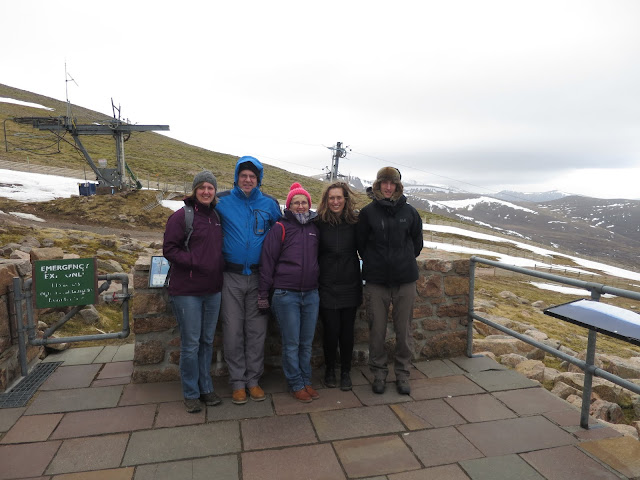Day 5 - CairnGorm and Loch Morlich
You can get the Funicular Railway up the UK's 6th highest mountain, CairnGorm, but for some reason we decided to walk between the two stations along the very aptly named Windy Ridge.
There was still snow on the ground in places (there's at least a little bit here all year round) so of course I had to make a snow angel! We're also very proud that we beat the ticket man's estimate of 1 - 1.5 hours walking. We did it in 50 minutes.
Once at the top station there are a few things to do ; an exhibition on the mountain and the area, some hot chocolate at the worlds highest cafeteria, and the chance to post your holiday postcards at the UK's highest postbox! Of course what you're really here for are the views, and even on a slightly overcast day they're worth the trip.
After lunch we stopped off at Loch Morlich which, slightly bizarrely, boasts and gorgeous sandy beach! Yes the water was absolutely freezing and no I was not even slightly tempted to go in but the novelty of it is great. Even in our coats, hats and boots we could admire the odd contrast.
Day 7 - Culloden Battlefield
This one made the list mainly because my brother kept telling us what a great visitor centre it was supposed to have, and in fairness to him it absolutely is excellent, and you really need it to fully appreciate what would otherwise look like just a large heathery field. Here's the basic story...
When Queen Elizabeth of England dies she leaves her throne to her nephew King James of Scotland, uniting the two countries for the first time ever, which greatly pleases... some people. A few generations later, after the English Civil War, the next King James is desposed and packs off the France while his sister Mary is put on the throne with her husband William of Orange (in Holland). This causes a great fuss between those who think this is fine (mainly the Government, who did it), and those who think this is terrible (the Jacobites, who think that only male heirs of James' line should be the king).
A while after that James' grandson Bonnie Prince Charlie sneaks back from France to Scotland, where he assembles an army of Jacobites and marches south. He could have made it to London and walked the whole conquest but instead his forces grind to a halt around Derby and, due to a lack of info, think they're not going to make it. They retreat back north to regroup, followed by the Government army, who chase them all over the shop, until finally they meet again at Culloden, just outside Inverness. Charlie hatches a plan to sneak up on his enemy by night, but his troops don't make it in time and have to face their battle tired, hungry, cold, and on a field not of their choosing.
The battle lasts about an hour, the first half of which is mainly shooting the next fifteen minutes is the Jacobite's notoriously terrifying Highland Charge, and the last fifteen of which is the Government forces mopping the floor with them. It's Charlie's first military loss but it's a big one and basically ends his campaign for the throne. What's strange about it is that so many of the Highlanders (who fought on both sides, not just the Jacobites) after following Charlie round the entire nation, ended up dying very close to their hometowns, so the even has a lot of personal significance for the clans and families in the area.
The Victorians romaticised the whole thing and began to popularise the battle as a story of the noble Scots versus the cruel English, and the headstones they erected at Culloden reflect this, but in fact the Jacobite Army featured Scotsmen, Englishmen, Frenchmen, and even one Spaniard, while the Government Army had yet more Scots, more English, and a bunch of Germans! Scans of the earth have been done, and hundreds of bodies are still there, buried under the grass and the heather. Such a loss of life over which of two men ought to be king.
There's a really good audio guide that takes you round the key areas of the battlefield, but as always you should take the tour, especially if this lady is leading it.
The long wall of the visitor centre. Each extant brick represents a death in the battle of Culloden.
Day 8 - Inverness
Our last day in Inverness, we went back into the city to see all the stuff we missed- mainly the Museum. I do like a museum, especially a free one, and actually they're often a really good way to get a handle on the area. The Inverness one is a great example. Favourite displays included the geology, puzzle-building neolithic vases, learning the Viking boardgame of Hnefatafl (which Nathan liked so much he bought a set of pieces in the shop, and rapidly became alarmingly good at), Felicity the escapee puma, beautiful Pictish stonework, trying to manhandle a traditional kilt onto our bodies (you have to lie on the floor - honest!)
With some time to kill in the afternoon, we tried something a bit different - an Escape the Room! You get locked into a room full of clues which lead you to a series of keys, but you have only an our to complete all the puzzles and find the key that lets you out of the room. We were doing pretty well, but then got stuck near the end because we'd not spotted a particularly subtle clue! After calling in our captor to give us a hint, we finished all the challenges and escaped, with only three minutes to spare!

I also made my traditional Holiday Brochure Collage, where I cut up all the leaflets we've accumulated and use them to make a picture of the area.

One more jog by the loch before bed...
Day 9 - The Lowlands
We left our cabin and began to make our way south, but at a very leisurely pace! After dropping Emma back at the little airport we mimbled gently past Stirling Castle to Falkirk, home of the Antonine Wall (the furthest north the Roman Empire ever reached before retreating to the line of Hadrian's Wall) and the Falkirk Wheel, a feat on engineering which lifts canal boats from the lower to the upper canal and back down again in an over-sized ferris wheel bucket. You know you're in the right area when you pass the giant metal Kelpies (mer-horses) on the motorway, which are replicated at the site of the wheel.
It seems vaguely wrong, and quite fascinating to watch something as big as a narrow boat be lifted in the air and swung out to the side over thin air - highly irregular for a boat! It's also a really nice area to spend a few hours in. The attraction of the wheel had led to a visitor centre, boat rides for tourists, wet play areas, and an ice cream hut, which we took advantage of! Being a short trip along the towpath from town, cyclists, joggers and walkers can get here easily, as well as the narrow boats which use the Wheel.
Finally we headed to the border via the road that leads through the Northumbrian National Park. It goes up over a high moor and the imaginary line is marked by two large standing stones, making a great viewpoint over the hills. From here, the landscape is almost identical on both sides - both our countries look exactly the same.
 |
| Looking north |

















No comments:
Post a Comment